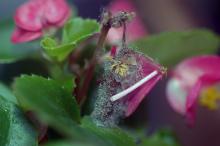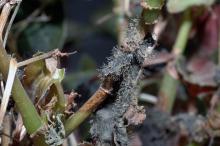See:
Greenhouse Plants, Ornamental - Gray Mold
Cause Botrytis cinerea, a fungus that survives in plant debris and is favored by high moisture and low temperatures. Infection occurs readily when the fungus has a food base, such as fading flowers or senescent leaves, from which it attacks healthy leaves. Under cool, humid conditions, and low light levels in greenhouses, the disease spreads rapidly.
Symptoms This gray mold fungus appears on leaves and flowers, causing a distinct blotch. Infected leaves and flower parts turn brown and die. On some cultivars, water-soaked spots develop, then turn brown and zonate over time. Established plants may rot at the crown. Cuttings may rot at their base.
Cultural control
- Remove and destroy infected plant parts, such as dead and dying flowers or leaves, from around plant and the potting soil surface
- Do not moisten leaves when watering.
- Maintain a steady, relatively dry environment by keeping greenhouse humidity below 90%. Heating the greenhouse at night (especially for zero or negative DIF) or venting around sunset may be necessary. Heating in the morning before sunup can also help prevent dew formation as air temperature increases faster than the temperature of plant parts. If using DROP or DIP for size control, do not let humidity rise above 90%.
Chemical control Best when used with cultural controls. Apply fungicide every 7 to 10 days. Make first application before disease appears. Do not use one chemical exclusively. Tank-mix and/or alternate products with different modes of action to prevent the build-up of resistant fungi. Limit the use of any one group during crop production. Due to plant sensitivity, try fungicides new to your production on a few plants first before wide scale use.
- Astun at 10 to 17 fl oz/100 gal water. Group 7 fungicide. 12-hr reentry.
- Broadform at 4 to 8 fl oz/100 gal water. Group 7 + 11 fungicide. 12-hr reentry.
- Daconil Weather Stik at 1.38 pints/100 gal water. Group M5 fungicide. 12-hr reentry.
- Decree 50 WDG at 0.75 to 1.5 lb/100 gal water. Group 17 fungicide. 12-hr reentry.
- Mancozeb-based products can be used as mixing partners and provide some protection. Group M3 fungicides. 24-hr reentry.
- Fore 80 WP at 1.5 lb/100 gal water plus a spreader-sticker.
- Protect DF at 1 to 2 lb/100 gal water plus 2 to 4 oz spreader-sticker.
- Medallion WDG at 2 to 4 oz/100 gal water. Use with oils or adjuvants may cause plant damage. Group 12 fungicide. 12-hr reentry.
- OHP 6672 4.5 F at 10 to 14.5 fl oz/100 gal water plus another fungicide. Group 1 fungicide. 12-hr reentry.
- Pageant at 12 to 18 oz/100 gal water. Do not use with organosilicone-based adjuvants. Group 7 + 11 fungicide. 12-hr reentry.
- Palladium at 4 to 6 oz/100 gal water. Avoid excessive runoff to small plants, which may result in stunting and/or chlorosis. Group 9 + 12 fungicide. 12-hr reentry.
- Phyton 27 at 1.3 to 2 fl oz/10 gal water. Group M1 fungicide. 48-hr reentry.
- Regime at 20.5 to 45.7 fl oz/A. Group BM01 fungicide. 4-hr reentry.
- Sil-Matrix at 1 to 4 quarts/100 gal water plus a nonionic surfactant. 4-hr reentry. O
- Spectro 90 WDG at 1 to 2 lb/100 gal water. Group 1 + M5 fungicide. 12-hr reentry.
- Spirato GHN at 2 to 4 fl oz/100 gal water. Use with oils or adjuvants may cause plant damage. Group 12 fungicide. 12-hr reentry.
- Terraguard SC at 4 to 8 fl oz/100 gal water. Group 3 fungicide. 12-hr reentry.
- Although not specifically registered on begonia, according to IR-4 data, iprodione (Chipco 26019) is safe on this crop. This compound provides good control of Botrytis on many other crops. Group 2 fungicide.
Biological control Research has shown that when Trichoderma harzianum 382 was incorporated into a light sphagnum peat potting media Botrytis blight was reduced.
- RootShield Plus Granules (Trichoderma harzianum Rifai strain T-22 and T. virens strain G-41) at 1 to 3 lb/cubic yard of soil mix. No restrictions on reentry when soil incorporated.
- Bio-Tam 2.0 or Tenet WP (Trichoderma asperellum and T. gamsii) is registered and may be effective. Use 0.5 to 1.5 lb/cubic yard of substrate. No restrictions on reentry when soil incorporated. O
- LALStop G46 WG (Clonostachys rosea [formerly Gliocladium catenulatum] strain J1446) at 0.13 oz/1 gal water. Do not use with other products in the tank. 4-hr reentry. H
Reference Horst, L.E., Locke, J, Krause, C.R., McMahon, R.W., Madden, L.V. and Hoitink, H.A.J. 2005. Suppression of botrytis blight of begonia by Trichoderma harzianum 382 in peat and compost-amended potting mixes. Plant Disease 89:1195-1200.



